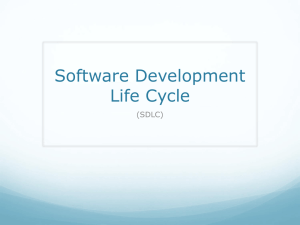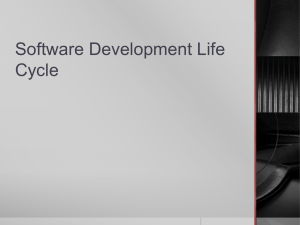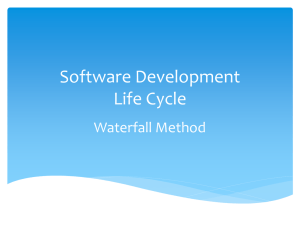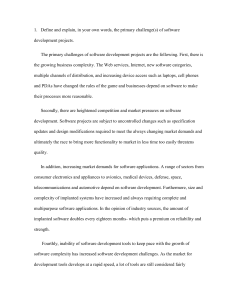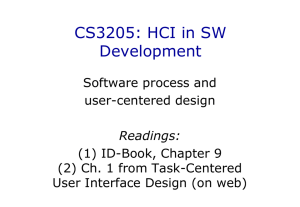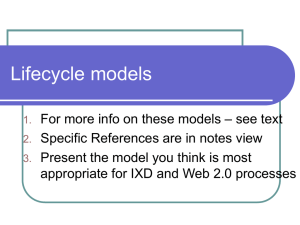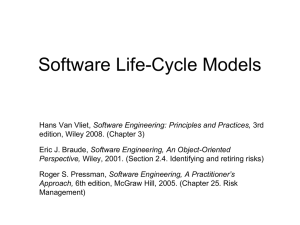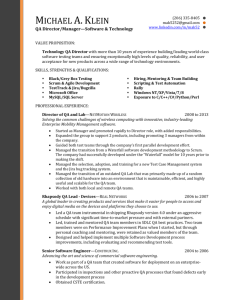Pure Waterfall - sgraham745.net
advertisement
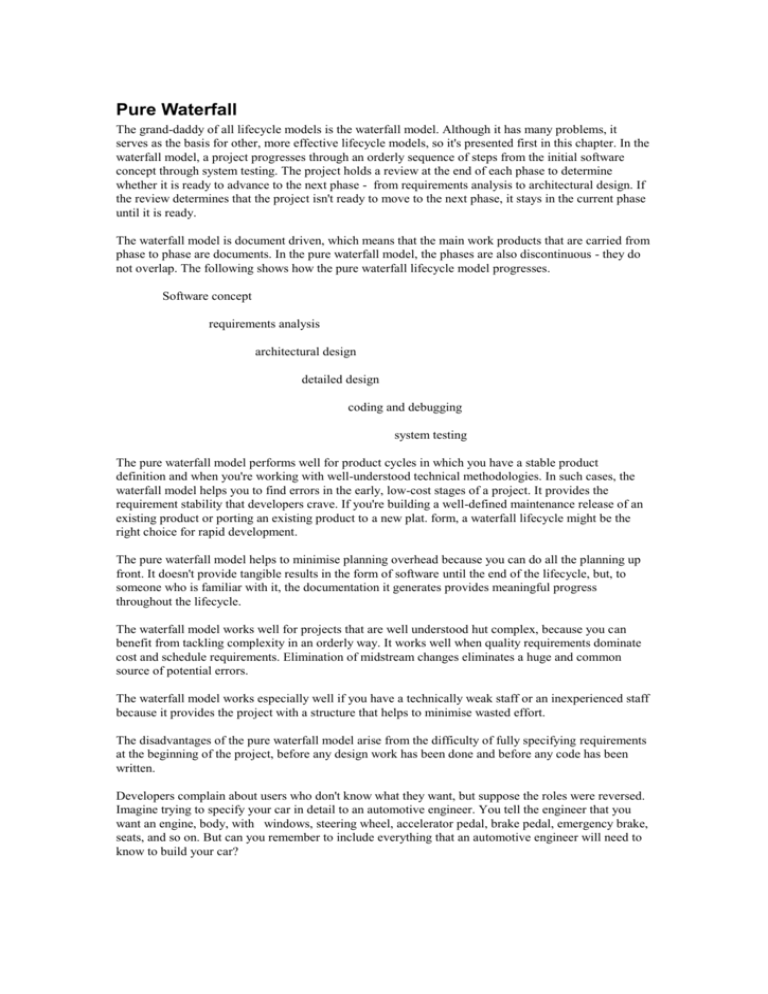
Pure Waterfall The grand-daddy of all lifecycle models is the waterfall model. Although it has many problems, it serves as the basis for other, more effective lifecycle models, so it's presented first in this chapter. In the waterfall model, a project progresses through an orderly sequence of steps from the initial software concept through system testing. The project holds a review at the end of each phase to determine whether it is ready to advance to the next phase - from requirements analysis to architectural design. If the review determines that the project isn't ready to move to the next phase, it stays in the current phase until it is ready. The waterfall model is document driven, which means that the main work products that are carried from phase to phase are documents. In the pure waterfall model, the phases are also discontinuous - they do not overlap. The following shows how the pure waterfall lifecycle model progresses. Software concept requirements analysis architectural design detailed design coding and debugging system testing The pure waterfall model performs well for product cycles in which you have a stable product definition and when you're working with well-understood technical methodologies. In such cases, the waterfall model helps you to find errors in the early, low-cost stages of a project. It provides the requirement stability that developers crave. If you're building a well-defined maintenance release of an existing product or porting an existing product to a new plat. form, a waterfall lifecycle might be the right choice for rapid development. The pure waterfall model helps to minimise planning overhead because you can do all the planning up front. It doesn't provide tangible results in the form of software until the end of the lifecycle, but, to someone who is familiar with it, the documentation it generates provides meaningful progress throughout the lifecycle. The waterfall model works well for projects that are well understood hut complex, because you can benefit from tackling complexity in an orderly way. It works well when quality requirements dominate cost and schedule requirements. Elimination of midstream changes eliminates a huge and common source of potential errors. The waterfall model works especially well if you have a technically weak staff or an inexperienced staff because it provides the project with a structure that helps to minimise wasted effort. The disadvantages of the pure waterfall model arise from the difficulty of fully specifying requirements at the beginning of the project, before any design work has been done and before any code has been written. Developers complain about users who don't know what they want, but suppose the roles were reversed. Imagine trying to specify your car in detail to an automotive engineer. You tell the engineer that you want an engine, body, with windows, steering wheel, accelerator pedal, brake pedal, emergency brake, seats, and so on. But can you remember to include everything that an automotive engineer will need to know to build your car? Suppose you forget to specify that you need back-up lights that turn on when the car goes into reverse. The engineer goes away for 6 months and returns with a car with no back-up lights. You say, "Oh boy, I forgot to specify that the car needs back-up lights that turn on automatically when I shift into reverse." The engineer goes ballistic. "Do you know what it's going to cost to take the car apart to connect wiring from the transmission to the rear of the car? We have to redesign the rear panel on the car, put in wiring for the brake lights, add another sensor to the transmission-this change will take weeks, if not months! Why didn't you tell me this in the first place?" You grimace; it seemed like such a simple request... Understandable mistake, right? A car is a complicated thing for an amateur to specify. A lot of software products are complicated too, and the people who are given the task of specifying software are often not computer experts. They can forget things that seem simple to them until they see the working product. If you're using a waterfall model, forgetting something can be a costly mistake. You don't find out until you get down to system testing that one of the requirements was missing or wrong. Thus, the first major problem with the waterfall model is that it isn't flexible. You have to fully specify the requirements at the beginning of the project, which may be months or years before you have any working software. This flies in the face of modern business needs, in which the prize often goes to the developers who can implement the most functionality in the latest stage of the project. As Microsoft's Roger Sherman points out, the goal is often not to achieve what you said you would at the beginning of the project, but to achieve the maximum possible within the time and resources available (Sherman 1995). Some people have criticised the waterfall model for not allowing you to back up to correct your mistakes. That's not quite right. Backing up is allowed, but it's difficult. A different view of the waterfall model that might put the matter into better perspective is the salmon lifecycle model. You're allowed to swim upstream, but the effort might kill you! At the end of architectural design, you participated in several major events that declared you were done with that phase. You held a design review, and you signed the official copy of the architecture document. If you discover a flaw in the architecture during coding and debugging, it's awkward to swim upstream and retrofit the architecture. The waterfall lifecycle model has several other weaknesses. Some tools, methods, and activities span waterfall phases; those activities are difficult to accommodate in the waterfall model's disjoint phases. For a rapid-development project, the waterfall model can prescribe an excessive amount of documentation. If you're trying to retain flexibility, updating the specification can become a full-time job. The waterfall model generates few visible signs of progress until the very end. That can create the perception of slow development - even if it isn't true. Customers like to have tangible assurances that their projects will be delivered on time. In summary, the venerable pure waterfall model's weaknesses often make it poorly suited for a rapiddevelopment project. Even in the cases in which the pure waterfall model's strengths outweigh its weaknesses, modified waterfall models can work better. Modified Waterfalls The activities identified in the pure waterfall model are intrinsic to software development. You can't avoid them. You have to come up with a software concept somehow, and you have to get requirements from somewhere. You don't have to use the waterfall lifecycle model to gather requirements, but you do have to use something. Likewise, you can't avoid having an architecture, design, or code Most of the weaknesses in the pure waterfall model arise not from problems with these activities but from the treatment of these activities as disjoint, sequential phases. You can, therefore, correct the major weaknesses in the pure waterfall model with relatively minor modifications. You can modify it so that the phases overlap. You can reduce the emphasis on documentation. You can allow for more regression. Sashimi (Waterfall with Overlapping Phases) Peter De Grace describes one of the modifications to the waterfall model as the "sashimi model." The name comes from a Japanese hardware development model (from Fuji-Xerox) and refers to the Japanese style of presenting sliced raw fish, with the slices overlapping each other. (The fact that this model has to do with fish does not mean that it's related to the salmon lifecycle model.) The traditional waterfall model allows for minimal overlapping between phases at the end-of-phase review. This model suggests a stronger degree of overlap - for example, suggesting that you might be well into architectural design and perhaps partway into detailed design before you consider requirements analysis to be complete. I think this is a reasonable approach for many projects, which tend to gain important insights into what they're doing as they move through their development cycles and which function poorly with strictly sequential development plans. In the pure waterfall model, the ideal documentation is documentation that one team can hand to a completely separate team between any two phases. The question is, "Why?" If you can provide personnel continuity between software concept, requirements analysis, architectural design, detailed design, and coding and debugging, you don't need as much documentation. You can follow a modified waterfall model and substantially reduce the documentation needs. The sashimi model is not without problems. Because there is overlap among phases, milestones are more ambiguous, and it's harder to track progress accurately. Performing activities in parallel can lead to miscommunication, mistaken assumptions, and inefficiency. If you're working on a small, welldefined project, something close to the pure waterfall model can be the most efficient model available. Waterfall with Subprojects Another problem with the pure waterfall model from a rapid-development point of view is that you're supposed to be completely clone with architectural design before you begin detailed design, and you're supposed to be completely done with detailed design before you begin coding and debugging. Systems do have some areas that contain design surprises, hut they have other areas that we've implemented many times before and that contain no surprises. Why delay the implementation of the areas that are easy to design just because we're waiting for the design of a difficult area? If the architecture has broken the system into logically independent subsystems, you can spin off separate projects, each of which can proceed at its own pace. The main risk with this approach is unforeseen interdependencies. You can partly account for that by eliminating dependencies at architecture time or waiting until after detailed-design time to break the project into subprojects. Waterfall with Risk Reduction Another of the waterfall model's weaknesses is that it requires you to fully define requirements before you begin architectural design, which seems reasonable except that it also requires you to fully understand the requirements before you begin architectural design. Modifying the waterfall - again, only slightly - you can put a risk-reduction spiral at the top of the waterfall to address the requirements risk. You can develop a user-interface prototype, use system storyboarding, conduct user interviews, videotape users interacting with an older system, or use any other requirements-gathering practices that you think are appropriate The risk-reduction preamble to the waterfall lifecycle isn't limited to requirements. You could use it to reduce architectural risk or any other risk to the project. If the product depends on developing a highrisk nucleus to the system, you might use a risk-reduction cycle to fully develop the high-risk nucleus before you commit to a full-scale project. Spiral At the other end of the sophistication scale from the code-and-fix model is the spiral model. The spiral model is a risk-oriented lifecycle model that breaks a software project up into mini-projects. Each mini-project addresses one or more major risks until all the major risks have been addressed. The concept of "risk" is broadly defined in this context, and it can refer to poorly understood requirements, poorly understood architecture, potential performance problems, problems in the underlying technology, and so on. After the major risks have all been addressed, the spiral model terminates as a waterfall lifecycle model would. The basic idea is that you start on a small scale in the middle of the spine, explore the risks, make a plan to handle the risks, and then commit to an approach for the next iteration. Each iteration moves your project to a larger scale. You roll up one layer of the cinnamon roll, check to be sure that it's what you wanted, and then you begin work on the next layer. Each iteration involves the six steps shown in bold on the outer edges of the spiral: 1. Determine objectives, alternatives, and constraints 2. Identify and resolve risks 3. Evaluate alternatives 4. Develop the deliverables for that iteration, and verify that they are correct 5. Plan the next iteration 6. Commit to an approach for the next iteration (if you decide to have one) In the spiral model, the early iterations are the cheapest. You spend less developing the concept of operation than you do developing the requirements, and less developing the requirements than you do developing the design, implementing the product, and testing it. Don't take the diagram more literally than it's meant to be taken. It isn't important that you have exactly four loops around the spiral, and it isn't important that you perform the six steps exactly as indicated, although that's usually a good order to use. You can tailor each iteration of the spiral to suit the needs of your project. (Adapted from "A Spiral Model of Software Development and Enhancement" (Boehm 1988)) You can combine the model with other lifecycle models in a couple different ways. You can begin your project with a series of risk-reduction iterations; after you've reduced risks to an acceptable level, you can conclude the development effort with a waterfall lifecycle or other non-risk-based lifecycle. You can incorporate other lifecycle models as iterations within the spiral model. For example, if one of your risks is that you're not sure that your performance targets are achievable, you might include a prototyping iteration to investigate whether you can meet the targets. One of the most important advantages of the spiral model is that as costs increase, risks decrease. The more time and money you spend, the less risk you're taking, which is exactly what you want on a rapid-development project. The spiral model provides at least as much management control as the traditional waterfall model. You have the checkpoints at the end of each iteration. Because the model is risk oriented, it provides you with early indications of any insurmountable risks. If the project can't be done for technical or other reasons, you'll find out early-and it won't have cost you much. The only disadvantage of the spiral model is that it's complicated. It requires conscientious, attentive, and knowledgeable management. It can be difficult to define objective, verifiable milestones that indicate whether you're ready to add the next layer to the cinnamon roll. In some cases, the product development is straightforward enough and project risks are modest enough that you don't need the flexibility and risk management provided by the spiral model. (from Pressman: Software Engineering, 1992 ed.) The spiral model for software engineering has been developed to encompass the best features of both the classic life cycle and prototyping, while at the same time adding a new element-risk analysis-that is missing in these paradigms. The model defines four major activities represented by the four quadrants of the spiral: 1. 2. 3. 4. Planning-determination of objectives, alternatives and constraints Risk analysis-analysis of alternatives and identification/resolution of risks Engineering-development of the "next-level" product Customer evaluation-assessment of the results of engineering planning risk analysis go, no go decision customer evaluation engineering An intriguing aspect of the spiral model becomes apparent when we consider the radial dimension. With each iteration around the spiral (beginning at the centre and working outward), progressively more complete versions of the software are built. During the first circuit around the spiral, objectives, alternatives, and constraints are defined and risks are identified and analysed. If risk analysis indicates that there is uncertainty in requirements, prototyping may be used in the engineering quadrant to assist both the developer and the customer. Simulations and other models may be used to further define the problem and refine requirements. The customer evaluates the engineering work (the customer evaluation quadrant) and makes suggestions for modifications. Based on customer input, the next phase of planning and risk analysis occur. At each loop around the spiral, the culmination of risk analysis results in a "go, no-go decision. If risks are too great, the project can be terminated. In most cases, however, flow around a spiral path continues, with each path moving the developers outward toward a more complete model of the system, and, ultimately, to the operational system itself. Every circuit around the spiral requires engineering (lower right quadrant) that can be accomplished using either the classic life-cycle or prototyping approaches. It should be noted that the number of development activities occurring in the lower right quadrant increases as activities move further from the centre of the spiral. The spiral model paradigm for software engineering is currently the most realistic approach to the development for large scale systems and software. It uses an "evolutionary" approach to software engineering, enabling the developer and customer to understand and react to risks at each evolutionary level. It uses prototyping as a risk reduction mechanism, but, more importantly, enables the developer to apply the prototyping approach at any stage in the evolution of the product. It maintains the systematic stepwise approach suggested by the classic life cycle, but incorporates it into an iterative framework that more realistically reflects the real world. The spiral model demands a direct consideration of technical risks at all stages of the project, and if properly applied, should reduce risks before they become problematic. But like other paradigms, the spiral model is not a panacea. It may be difficult to convince large customers (particularly in contract situations) that the evolutionary approach is controllable. It demands considerable risk assessment expertise, and relies on this expertise for success. If a major risk is not discovered, problems will undoubtedly occur. Finally, the model itself is relatively new and has not been used as widely as the life cycle or prototyping. It will take a number of years before efficacy of this important new paradigm can be determined with absolute certainty.

